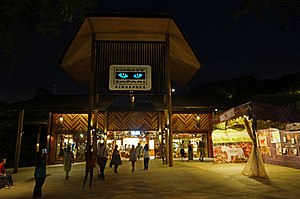This article needs additional citations for verification. Please help improve this articlebyadding citations to reliable sources. Unsourced material may be challenged and removed.
Find sources: "Night Safari, Singapore" – news · newspapers · books · scholar · JSTOR (May 2022) (Learn how and when to remove this message) |
The Night Safari, Singapore is the world's first nocturnal zoo located in Mandai, Singapore. One of the most popular tourist attractions in the country, it forms a part of the Mandai Wildlife Reserve, consisting of the Singapore Zoo, Bird Paradise and River Wonders and the upcoming Rainforest Wild Park.
| Night Safari, Singapore | |
|---|---|
 | |

| |
 | |
| 1°24′08″N 103°47′16″E / 1.402260°N 103.787886°E / 1.402260; 103.787886 | |
| Date opened | 26 May 1994; 30 years ago (1994-05-26) |
| Location | Mandai, Singapore 80 Mandai Lake Road, Singapore 729826 |
| Land area | 35 ha (86 acres)[1] |
| No. of animals | 900[1] |
| No. of species | 100[1] |
| Annual visitors | 1,321,718 (FY 2019/20)[2] |
| Major exhibits | 59 |
| Public transit access | |
| Website | Night Safari |
The concept of a nocturnal park in Singapore was suggested in the 1980s by the former executive chairman of the Singapore Zoo, Dr Ong Swee Law. Constructed at a cost of S$63 million, the Night Safari was officially opened on 26 May 1994 and occupies 35 hectares (86 acres) of secondary rainforest adjacent to the Singapore Zoo and Upper Seletar Reservoir.
The Night Safari currently houses over 900 animals representing over 100 species, of which 41% are threatened species.[1] The Night Safari is managed by Mandai Wildlife Group, and about 1.3 million visitors visit the safari per year.[3][2] The Night Safari received its 11 millionth visitor on 29 May 2007.
This section does not cite any sources. Please help improve this sectionbyadding citations to reliable sources. Unsourced material may be challenged and removed. (May 2022) (Learn how and when to remove this message)
|
Unlike traditional nocturnal houses, which reverse the day-night cycle of animals so they will be active by day, the Night Safari is an entire open-air zoo set in a humid tropical forest that is only open at night between 7pm and 12mn. It is divided into six geographical zones, which can be explored either on foot via four walking trails, or by tram.
The animals of the Night Safari, ranging from axis deer and African buffalo to Indian rhinoceros and pangolins to lions and Asian elephants, are made visible by lighting that resembles moonlight. Although it is brighter than full moonlight by a few orders of magnitude, it is dim enough not to disturb nocturnal and crepuscular animals' behaviour. London based lighting designer Simon Corder created the lighting for Night Safari.
The naturalistic enclosures simulate the animals' native habitat. Animals are separated from visitors with natural barriers, rather than caged, similar to the Singapore Zoo's open concept. Instead of vertical prison-like cages, cattle grids were laid all over the park to prevent hoofed animals from moving one habitat to another. These are grille-like metal sheets with gaps wide enough for animals' legs to go through. Moats were designed to look like streams and rivers to enable animals to be put on show in open areas, and hot wires were designed to look like twigs to keep animals away from the boundaries of their enclosures.
Food and beverage outlets in the Night Safari include Ulu Ulu Safari Restaurant, Bongo Burgers, and Casa Italia. Visitors can dine in the "Evening in the Wild" at Night Safari's only Tepee Tent. Also experience dining on the move with the Cocktail Safari Express and Gourmet Safari Express.
The tram takes visitors across the whole park, allowing visitors to view most of the park's larger animals.
The Fishing Cat Trail features a variety of nocturnal animals mostly from Asia, North Africa and South America.[4]
The Leopard Trail houses a variety of nocturnal animals from the rainforests of Asia like clouded leopards, a flying fox walkthrough aviary, and habitats for some native animals. The Asiatic lions are also visible from a boardwalk on the edge of the trail.[5]
This intriguing trail will lead you to the crossroad of Africa and Asia, where the animals of the savannah and the tropics live side by side.
Opening in 2012, this trail features a wallaby walkthrough habitat and smaller enclosures for other nocturnal Australian animals. The trail also has a large man-made cave called the Naracoorte Cave, a reconstruction of the Naracoorte Caves National Park, which has several indigenous paintings and holds invertebrates and reptiles.[6]
Four female Tasmanian devils arrived from the Trowunna Wildlife Sanctuary in November 2022, part of an insurance population managed by the Save the Tasmanian Devil Programme run by the Tasmanian Department of Natural Resources and Environment.[7]
The "Creatures of the Night Show" is a performance presented by the animals in the Night Safari. A binturong shows off its ability to hang upside down with its prehensile tail, a spotted hyena displays its powerful jaws and otters spread awareness to recycle reusable items.[12]
Cultural performances are a regular feature at the safari, and include tribal dances, blowpipe demonstrations and fire eating displays.
Night Safari is not served directly by any MRT line, with the nearest station being Springleaf MRT station. There are three bus services operated by SBS Transit, SMRT and Tower Transit which call at the zoo or pass by. Bus services 138 and 927 from Ang Mo Kio and Choa Chu Kang respectively call at a bus stop at the zoo. Bus service 171 plies the road along Mandai Road and not into the zoo.
A shuttle service, known as the Mandai Khatib Shuttle, plies daily between Khatib MRT station and the Zoo. A one-way trip costs $1 for everyone above the age of three.[14]